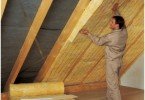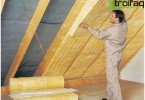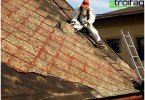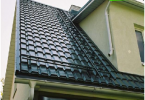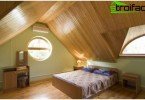Roof insulation
Why do we need roof insulation? Everyone knows that the main purpose of the roof is to protect the building from rain and heat loss. So, using heat-insulating materials, you can minimize heat loss, that is, make living in the house the most comfortable and economical in terms of heating costs. We will devote this publication to this important issue, considering it from all sides..
Content
- What material to choose?
- Secrets of installing insulation on a pitched roof
- How to insulate a flat roof?
What material to choose?
Let’s start with the main thing. Thermal insulation solves four problems:
- in areas where there are sharp changes in temperature, a thermal insulation layer protects the building from sudden fluctuations in street air;
- damping, blackening of concrete floors is minimized;
- an optimal microclimate is created in the premises;
- saving money on heat consumption.
Some people believe that you can come to the store and purchase some kind of insulation without attaching special importance to the characteristics of the material. This approach to business cannot be called correct, so now we will consider the main types of heat insulators.

Mineral wool limits heat flow well
Mineral wool is the most common material produced by manufacturers in the form of rolls, mats, plates. It is soft, easy to install and has good qualities..
This is important to know: for a penthouse and a pitched roof, mineral wool with a low density, laminated with foil or fiberglass, is most suitable. As for the arrangement of flat roofs, it is better to give preference to cotton wool of increased rigidity.
The properties of mineral wool deserve increased attention:
- incombustibility – in case of fire, this material does not allow the spread of fire;
- to reduce water absorption, mineral wool is treated with specific water-repellent substances;
- strength – this indicator depends on the ordering of the fibers;
- excellent thermal insulation abilities;
- high-quality (!) material lasts a very long time.
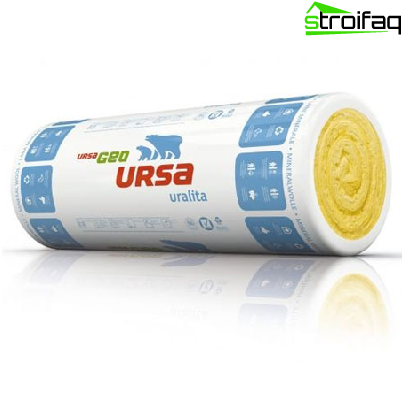
URSA – a competitive product in the building materials market
URSA staple fiberglass is a functional, wide-profile insulation used not only for roof insulation, but also for arranging floors, ceilings, and external walls. This is a modern technological building material that fully meets the requirements of thermal protection and hygiene. What exactly are the advantages of staple fiberglass? There are several of them:
- elasticity and high recovery rates – thanks to these properties, the material is easily mounted;
- elasticity – fiberglass can insulate structures with surfaces of various shapes;
- vibration resistance and excellent sound absorbing properties;
- good heat-insulating ability and low weight;
- the fibers are characterized by excellent chemical resistance, they do not absorb steam, do not have corrosive elements in their composition;
- products undergo water repellent treatment.
It is important to know: URSA is made from molten glass melt – a method of vertical blowing of fibers by a stream of hot gases is applied.
Extruded polystyrene foam is a new building material that has gained popularity, despite its relatively short lifetime. In fact, this is ordinary polystyrene foam, only processed by extrusion with the introduction of a blowing agent. What are its properties? We will immediately answer this question:
- low thermal conductivity, chemical resistance;
- stability and security;
- low rates of water absorption – the reason is that the material has a closed cell structure;
- zero capillarity, high moisture resistance;
- whole microstructure is a single substance with intermolecular bonds;
It is worth paying attention: the cell walls are a continuous mass of substance, therefore, elements from the environment enter only open cells that are on sections, lateral surfaces.
- ease of processing, light weight;
- high compressive strength;
- durability – extruded polystyrene foam does not rot, and the estimated service life is 100 years;
- ease of use.
In general, the use of a certain type of insulation depends on a number of its physicochemical parameters:
- vapor permeability and hydrophobicity – these indicators show the water-repellent properties of the material and its ability to remove moisture vapor through the structure to the outside;
- thermal conductivity coefficient – naturally, the lower this parameter, the better the insulation maintains temperature;
- resistance to deformation – we are talking about maintaining the original thickness during prolonged exposure to mechanical stress;
- combustibility – the importance of this property is clear without unnecessary words.
Secrets of installing insulation on a pitched roof
Warming of ramps is in demand today, because now comfortable lofts and attics are in fashion.
This is important to know: the thermal insulation layer on the attic floor is not arranged, because then the access of heat from the main rooms is blocked.
For isolation of slopes, hard or semi-rigid plates are most suitable. And what is the direct process of laying insulation? It consists of the following steps:
- measuring the thickness of the rafters, the distance between them;
- preparation of heat-insulating plates in accordance with the obtained dimensions. One thing to keep in mind here: the thickness of the plates should be slightly larger and the width slightly less. An additional centimeter in width is needed for a strong joint of the plates, and a gap of 2.5 cm between the heat-insulating layer and the roofing is necessary for sufficient air circulation;
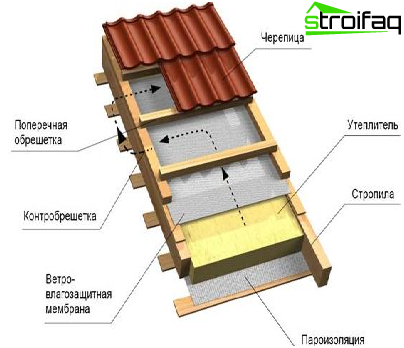
Roofing Pie – Layered Design
- installation should begin from the bottom of the ramp, gradually moving up. Products are attached in several ways: in the first case, it is assumed to use rails that are perpendicular to the rafters, in another case, a cord made of durable nylon is used.
On the inside, a vapor barrier film is laid on the insulation, and then trimmed with drywall, lining. But from the outside it is necessary to equip a layer of hydro and wind insulation. For this purpose, diffusion / anti-condensation membranes are used, well, then the roofing material is already laid.
How to insulate a flat roof?
The process of thermal insulation cannot be called difficult, but great attention must be paid to the problem of placement of lighting devices. As for the choice of material, you need to give preference to fire-resistant foam boards (thickness 25 mm). The process of laying them is as follows:
- the first strip is screwed to the ceiling, a polystyrene foam plate is glued to it using special glue / mastic;
- after 40 cm the next strip is screwed and the second plate is similarly glued;
- similarly, alternating the laying of planks and slabs, the entire ceiling is insulated.
By the way, the attic floor can be insulated with bulk heat-insulating materials in the form of granules. The insulation process is almost similar to the above processes. But still we specify the essence of its implementation: a layer of materials is poured between the bars, leveled with a bar in order to obtain the same thickness;
This is important to know: bulk materials are granules or balls of cork, wool, shale minerals. The mass of the bag is 110 kg and its contents are enough to warm a meter of a square surface.
In addition to everything, external insulation of a flat roof is also possible. Outside, the exploited flat roof is insulated with rigid plates. To do this, on top of the bars of the supporting structure, you need to lay a solid base of panels. Heat-insulating plates are laid on them, which are subsequently pressed down by paving slabs, pebbles.
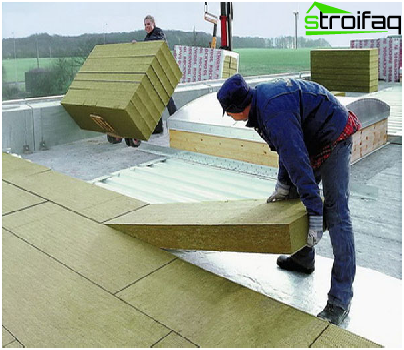
If the roof will be intensively exploited, insulation boards should have increased rigidity
This procedure seems easy, but this is an erroneous opinion. When carrying out a set of works on their own, the risk is very high that the structure will not support the weight of the materials, and the coating itself will leak.
The publication examined the main heat-insulating materials and methods of roof insulation. But whether a person can do everything with his own hands, it already depends on his skills, professionalism in this matter. But one thing is certain for sure: there are no trifles in building, so you need to evaluate your abilities and decide whether the help of specialists is needed. Remember, even one small mistake can lead to negative consequences, that is, you can not save on materials, and insulation must be carried out qualitatively, taking into account the rules and requirements!


